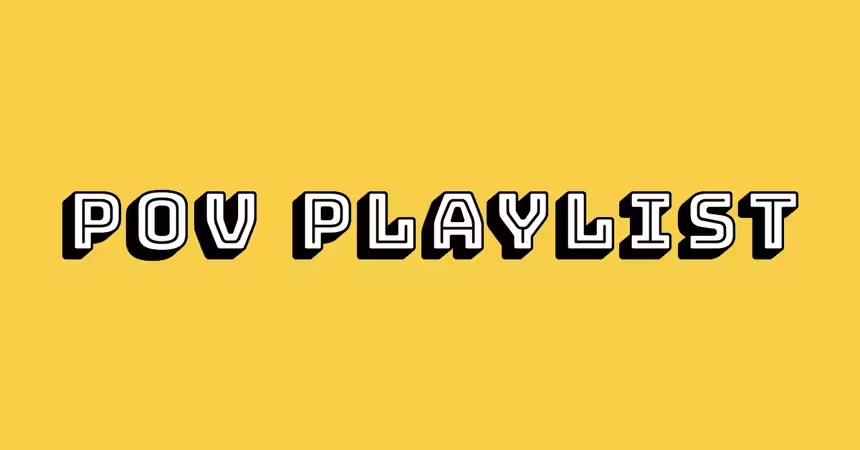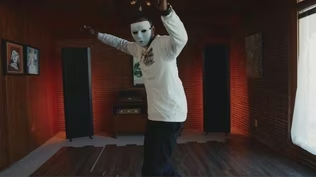
Are You Down?
Special | 12m 19sVideo has Closed Captions
A portrait of the life and work of Jamaican New Yorker and visual artist Michael Richards.
Highlighting his powerful sculpture practice and beautiful spirit, a portrait of the life and work of Jamaican New Yorker and visual artist, Michael Richards.
Problems playing video? | Closed Captioning Feedback
Problems playing video? | Closed Captioning Feedback
Major funding for POV is provided by PBS, The John D. and Catherine T. MacArthur Foundation, the Wyncote Foundation, Reva & David Logan Foundation, the Open Society Foundations and the...

Are You Down?
Special | 12m 19sVideo has Closed Captions
Highlighting his powerful sculpture practice and beautiful spirit, a portrait of the life and work of Jamaican New Yorker and visual artist, Michael Richards.
Problems playing video? | Closed Captioning Feedback
How to Watch POV
POV is available to stream on pbs.org and the free PBS App, available on iPhone, Apple TV, Android TV, Android smartphones, Amazon Fire TV, Amazon Fire Tablet, Roku, Samsung Smart TV, and Vizio.

POV Playlist
Every two weeks, we curate a selection of POV docs, old and new, around a central theme. Stream while you can — until the next Playlist!Providing Support for PBS.org
Learn Moreabout PBS online sponsorshipPart of These Collections

POV Shorts
Independent short films curated by America's longest-running documentary series
View Collection
Celebrating the Culture: Kwanzaa 2025
In honor of Kwanzaa, these titles explore the guiding pillars that keep this tradition in our hearts
View CollectionProviding Support for PBS.org
Learn Moreabout PBS online sponsorship♪♪ [ Object sliding ] -[ Man speaking indistinctly ] Down.
[ Indistinct conversations ] [ Thud ] ♪♪ -I first met Michael in November of 1997.
Louis was showing me the ArtCenter, and Michael came out of his studio and joined us, and he was very gracious.
And that's where our rich conversations really took off.
♪♪ -My first impression of Michael was this very tall, gentle giant.
I don't know if he knew it, but he kind of, like, seduces you when he talks to you.
-He was smart.
He was funny.
And he was a great teacher to me.
-I had just gotten out of art school and I'm trying to de-learn everything that I've been indoctrinated with.
And here's Michael.
-I wouldn't be here without my art family, if you will, and he was art family.
[ Indistinct conversations ] ♪♪ -He moved fluidly between spaces, social spaces, you know, artistic spaces.
The studio, the street, the museum, the gallery.
-This is family.
-This is family.
Okay.
-[ Speaks indistinctly ] -Had so many different friendships.
♪♪ -He made people laugh.
Michael was just good people.
So you were happy to be around him.
[ Laughter ] ♪♪ -A lot of my work deals with issues of immigration, assimilation, Black culture, um... and attraction/repulsion to sort of the larger society.
And I use -- I've been traveling since I was a child.
I grew up in Jamaica, in the West Indies.
And planes have always been a big part of my life.
Pilots, in my work, function as a symbol of, um -- They're almost images of transcendence.
They're these beings that go up into the sky, you know, just the offer a freedom of escape, of, you know, coming to a new land, of you know, the Yellow Brick Road and success and all of that.
But you always come back down to the ground, you know?
It's always, you know, maybe -- I'm Catholic, so maybe it's a little too religious, but it's, you know, always this descent, you know, from the high points back down to the ground and always a struggle of trying to transcend, to be high again.
♪♪ -There is almost no material in Michael Richards' work that I can think of that doesn't have the multiple meanings and references.
♪♪ ♪♪ Each material that he uses -- There's tar.
There's barbed wire.
Feathers.
Mirrors.
Each of them has both a really charged meaning, sometimes referring to racist stereotypes... ♪♪ ...or also a poetic kind of meaning in society, a mirror reflecting you back while you're looking at the work.
[ Indistinct conversations ] ♪♪ -One aspect of the work that really means a lot is the fact that Michael casts most of his sculptures from his own body.
-He talked about double consciousness and what does it mean to be Black and American and have these warring ideals in one Black body.
And Caribbean adds a different layer, so it's like -- I'm a fine artist, I'm trained in the Western art tradition.
But I don't have the same assumptions about America or the West that many people who are celebrated artists do, and so that work is gonna be different.
[ Fans whirring ] ♪♪ -We have envisioned this exhibition in four primary components.
So, we have the sculptures, obviously.
Sculpture was the biggest body of work that Michael Richards created.
Then we have the drawings which are behind you, if you turn around, on this wall over here.
And then we have these installation images which represent works that we couldn't represent physically in the exhibition.
And then we also have over here an area with a vitrine and remembrances to represent Michael Richards during his life and through friends, colleagues, and peers who remember him through their words.
♪♪ -He did the series of drawings.
"Escape Plan," 1 to 12.
And he had text for each of the drawings.
♪♪ ♪♪ -Largely it was a philosophical thing of trying to get to a world where you aren't constrained and confined by the racism that defines this world and, because you are Black, actually can literally kill you.
♪♪ -Yesterday, I fulfilled one of my ambitions as a combat pilot.
I got one airplane.
-An American far from home, fighting a war around the world.
Listen again.
-This was my leader.
And the second ship was me.
And two...came on my right.
I turned right and put up a stone wall of bullets.
-A wall of bullets.
It wasn't so long ago these men were students in a university, workmen in a shipyard.
♪♪ [ Indistinct conversations ] ♪♪ -The first revelatory moment was seeing Tar Baby vs. St. Sebastian.
Standing there -- Like, I get chills right now.
[ Laughs ] ♪♪ -You know, he's dressed up as a Tuskegee Airmen, and there are these planes flying in and out.
I mean, that one is haunting.
♪♪ -When Michael told me that he got a studio and he was moving back to New York City, and then he told me it's going to be at the Twin Towers, I -- It was very odd for me.
A studio in an office building.
How will that work?
The first thing that came into my head was like, "How is he gonna keep it clean?"
He says, "Yeah, but it's free.
They're offering it to me."
I'm like, "Alright."
-My studio was in Williamsburg on Berry and North 8th.
and had a clear view out of my back window of the skyline, and I could see the Towers.
-We drove to New York to drop off works.
We stayed there for about a week.
♪♪ -He was working on a second version of Tar Baby.
He was so excited about the new work.
-Got to Miami on the 11th.
In the morning.
I think around 5:00 in the morning.
-Phone wakes me up, and it's my mother in Miami screaming, like, "Did you see it?"
And I was like, "What are you talking about?"
I look out the back window, and I see the first -- Tower 1 on fire, and then I see the second plane coming in, like, in slow motion, and it hits.
[ People screaming ] ♪♪ -Oh... [ Sirens wailing ] ♪♪ -I thought to myself, "No.
It's alright.
It's late.
Michael must have left."
He had to be at the Studio Museum at 9:00 in the morning.
[ Radio chatter ] [ Indistinct conversations ] ♪♪ -Apparently Michael had spent the night there.
He had really gotten so excited working in his studio that he had decided to spend the night because it got late and he was tired.
And we didn't know this initially, but slowly his friends who were -- shared studio space with him sort of filled in a lot of those missing gaps.
[ Sirens wailing ] ♪♪ It was such a strange time.
♪♪ -Where's Michael?
A couple of days later, we realized that no one had seen him or talked to him.
[ Radio chatter, sirens wailing ] -We're moving some people.
Be advised.
We're moving some people... -There he is.
Superstar.
-Michael Richards.
[ Indistinct conversations ] -How you doing?
-How are you?
-Alright.
Hi.
[ Indistinct conversations ] -Michael's legacy -- or Michael's entry point, I think, to me, is, like, that first generation of artists that were raised in hip-hop, not giving a... of what was going on, whether it was being accepted by the galleries or the curators.
They were just pushing forward and making this work.
Where would all these artists be now had it not been for that group of artists that did that kind of work?
-The artwork is brilliant.
Our younger generation of artists is now thinking about Blackness, Black bodies, escape, oppression, colonialism.
Those are all things that Michael was exploring, you know, 25 years ago, and so I'm glad that he's being written into art history.
His work should be included and celebrated and known about.
[ Drills whirring ] -People talk about the art and the importance of the art, but just as often people talk about him as a friend.
-The one thing that I miss most about Michael is Michael.
-Let's do a tour.
-Okay.
-Okay.
-And here we have the best piece in the show.
[ Laughter ] -Come on.
[ Laughter ] Okay.
Let's talk about this piece here.
-This is the ass of the... [ Laughter ] -I was looking at it and I said, "That's not Michael's butt.
[ Laughter ] That isn't Michael's butt."
I said, "Who is it?"
♪♪ ♪♪ ♪♪ ♪♪
Support for PBS provided by:
Major funding for POV is provided by PBS, The John D. and Catherine T. MacArthur Foundation, the Wyncote Foundation, Reva & David Logan Foundation, the Open Society Foundations and the...















